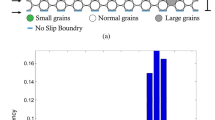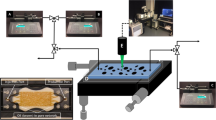Abstract
CO2 injection into oil reservoirs is widely accepted as an effective enhanced oil recovery and CO2 storage technique. While oil recovery and CO2 storage potential of this technique have been studied extensively at the core-scale, complex multiphase flow and fluid–fluid interactions at the pore scale during near-miscible CO2 injection have not, and this area needs more study. To address this, a unique high-pressure microfluidic system was implemented which allows for the optical visualisation of the flow using optical microscopy. The results show that during tertiary near-miscible CO2 injection, when CO2 phase contacts the oil, the oil spreads as a layer between the CO2 phase and water preventing CO2 phase from contacting the water phase. This is attributed to the positive value of the spreading coefficient. Furthermore, due to the presence of pore-scale heterogeneity in the chip, an early breakthrough of CO2 was observed causing a large amount of oil to be bypassed. However, after CO2 breakthrough, CO2 gradually started to diffuse and flow inside the bypassed oil zones in the transverse directions which is a characteristic of capillary crossflow. The driving force for this capillary crossflow was the interfacial tension gradient formed by the diffusion of CO2 into the oil phase and the extraction of light to medium hydrocarbon components from the oil into the CO2 phase. The same mechanism led to the recovery of the bypassed oil trapped in dead-end pores. This unique mechanism produced the majority of the bypassed oil after CO2 breakthrough and significantly increased the oil recovery. In our three-phase flow water-wet system, CO2 flow displaced the water through a multiple displacement mechanism which is unique to three-phase flow. CO2 displaced the oil in oil-filled pores thorough bulk flow, and the spreading oil layers were gradually produced by layer flow.
















Similar content being viewed by others
References
Ahmed, T.: Fundamentals of reservoir fluid flow. In: Work Guid to Reserv Rock Prop Fluid Flow, pp. 117–246 (2013). https://doi.org/10.1016/b978-1-85617-825-9.00003-x
Akai, T., Xue, Z., Yamashita, Y., Yoshizawa, M.: Application of CO2 micro bubble for the innovative CO2-EOR. In: Abu Dhabi International Petroleum Exhibition and Conference, vol. 8 (2015). https://doi.org/10.2118/177672-ms
Al-Menhali, A.S., Krevor, S.: Capillary trapping of CO2 in oil reservoirs: observations in a mixed-wet carbonate rock. Environ. Sci. Technol. 50(5), 2727–2734 (2016). https://doi.org/10.1021/acs.est.5b05925
AlQuaimi, B.I., Rossen, W.R.: Study of foam generation and propagation in fully characterized physical-model fracture. J. Pet. Sci. Eng. 2019(175), 1169–1181 (2018). https://doi.org/10.1016/j.petrol.2018.06.025
Bachu, S.: Screening and ranking of sedimentary basins for sequestration of CO2 in geological media in response to climate change. Environ. Geol. 44(3), 277–289 (2003). https://doi.org/10.1007/s00254-003-0762-9
Bahralolom, I.M., Orr, F.M.: Solubility and extraction in multiple-contact miscible displacements: comparison of N//2 and Co//2 flow visualization experiments. Soc. Pet. Eng. AIME SPE 1(February), 363–370 (1986). https://doi.org/10.2118/15079-pa
Campbell, B.T., Orr, F.M.: Flow visualization for Co2/crude oil displacements. Soc. Pet. Eng. J. 25(5), 665–678 (1985). https://doi.org/10.2118/11958-PA
Ceyssens, F., Puers, R.: Deep etching of glass wafers using sputtered molybdenum masks. J. Micromech. Microeng. (2009). https://doi.org/10.1088/0960-1317/19/6/067001
Ghasemi, M., Astutik, W., Alavian, S.A., et al.: Impact of pressure on tertiary-CO2 flooding in a fractured chalk reservoir. J. Pet. Sci. Eng. 167(April), 406–417 (2018). https://doi.org/10.1016/j.petrol.2018.04.022
Golkari, A., Riazi, M.: Experimental investigation of miscibility conditions of dead and live asphaltenic crude oil–CO2 systems. J. Pet. Explor. Prod. Technol. 7(2), 597–609 (2017). https://doi.org/10.1007/s13202-016-0280-4
Grigg, R.B., Gregory, M.D., Purkaple, J.D.: The effect of pressure on improved oilflood recovery from tertiary gas injection. SPE Reserv. Eng. 12(03), 179–188 (1997). https://doi.org/10.2118/35426-PA
Hamdi, Z., Awang, M.: Oil recovery study by low temperature carbon dioxide injection in high-pressure high-temperature micromodels. Int. J. Energy Environ. Eng. 11(11), 1123–1129 (2017)
Hemmati-Sarapardeh, A., Ayatollahi, S., Ghazanfari, M.H., Masihi, M.: Experimental determination of interfacial tension and miscibility of the CO2-crude oil system; temperature, pressure, and composition effects. J. Chem. Eng. Data 59(1), 61–69 (2014). https://doi.org/10.1021/je400811h
Hill, B., Hovorka, S., Melzer, S.: Geologic carbon storage through enhanced oil recovery. Energy Procedia 37, 6808–6830 (2013). https://doi.org/10.1016/j.egypro.2013.06.614
Huang, T., Zhou, X., Yang, H., Liao, G., Zeng, F.: CO2 flooding strategy to enhance heavy oil recovery. Petroleum 3(1), 68–78 (2017). https://doi.org/10.1016/j.petlm.2016.11.005
Khather, M., Saeedi, A., Myers, M.B., Verrall, M.: An experimental study for carbonate reservoirs on the impact of CO2-EOR on petrophysics and oil recovery. Fuel 2019(235), 1019–1038 (2018). https://doi.org/10.1016/j.fuel.2018.08.094
Kuuskraa, V.A., Godec, M.L., Dipietro, P.: CO2 Utilization from “Next Generation” CO2 enhanced oil recovery technology. Energy Procedia 37, 6854–6866 (2013). https://doi.org/10.1016/j.egypro.2013.06.618
Li, X., Akbarabadi, M., Karpyn, Z.T., Piri, M., Bazilevskaya, E.: Experimental investigation of carbon dioxide trapping due to capillary retention in saline aquifers. Geofluids 15(4), 563–576 (2015). https://doi.org/10.1111/gfl.12127
Ma, J., Wang, X., Gao, R., et al.: Study of cyclic CO2 injection for low-pressure light oil recovery under reservoir conditions. Fuel 174, 296–306 (2016). https://doi.org/10.1016/j.fuel.2016.02.017
Metcalfe, R.: Effects of impurities on minimum miscibility pressures and minimum enrichment levels for CO2 and rich-gas displacements. Soc. Pet. Eng. J. 22(02), 219–225 (1982). https://doi.org/10.2118/9230-pa
Metcalfe, R.S., Yarborough, L.: The effect of phase equilibria on the CO2 displacement mechanism. Soc. Pet. Eng. J. 19(04), 242–252 (1979). https://doi.org/10.2118/7061-PA
Mojtaba, S., Behzad, R., Rasoul, N.M., Mohammad, R.: Experimental study of density-driven convection effects on CO2 dissolution rate in formation water for geological storage. J. Nat. Gas Sci. Eng. 21, 600–607 (2014). https://doi.org/10.1016/j.jngse.2014.09.020
Nemati Lay, E., Taghikhani, V., Ghotbi, C.: Measurement and correlation of CO2 solubility in the systems of CO2 + toluene, CO2 + benzene, and CO2 + n-hexane at near-critical and supercritical conditions. J. Chem. Eng. Data 51(6), 2197–2200 (2006). https://doi.org/10.1021/je0602972
Nobakht, M., Moghadam, S., Gu, Y.: Mutual interactions between crude oil and CO2 under different pressures. Fluid Phase Equilib. 265(1–2), 94–103 (2008). https://doi.org/10.1016/j.fluid.2007.12.009
Perrin, J.C., Benson, S.: An experimental study on the influence of sub-core scale heterogeneities on CO2 distribution in reservoir rocks. Transp. Porous Media 82(1), 93–109 (2010). https://doi.org/10.1007/s11242-009-9426-x
Rahman, T., Lebedev, M., Barifcani, A., Iglauer, S.: Residual trapping of supercritical CO2 in oil-wet sandstone. J. Colloid Interface Sci. 469, 63–68 (2016). https://doi.org/10.1016/j.jcis.2016.02.020
Robin, M., Behot, J., Sygouni, V.: CO2 injection in porous media: observations un glass micromodels under reservoir conditions. SPE Improv. Oil Recovery Symp. 2, 1–15 (2012). https://doi.org/10.2118/154165-ms
Sandrea, I., Sandrea, R.: Global oil reserves-1: recovery factors leave vast target for EOR technologies. Oil Gas J. 105, 44–48 (2007)
Seyyedi, M., Sohrabi, M.: Pore-scale investigation of crude oil/CO2 compositional effects on oil recovery by carbonated water injection. Ind. Eng. Chem. Res. 56(6), 1671–1681 (2017). https://doi.org/10.1021/acs.iecr.6b04743
Seyyedi, M., Mahzari, P., Sohrabi, M.: An integrated study of the dominant mechanism leading to improved oil recovery by carbonated water injection. J. Ind. Eng. Chem. 45, 22–32 (2017a). https://doi.org/10.1016/j.jiec.2016.08.027
Seyyedi, M., Mahzari, P., Sohrabi, M.: A comparative study of oil compositional variations during CO2 and carbonated water injection scenarios for EOR. J. Pet. Sci. Eng. 2018(164), 685–695 (2017b). https://doi.org/10.1016/j.petrol.2018.01.029
Seyyedi, M., Mahzari, P., Sohrabi, M.: A fundamental micro scale study of the roles of associated gas content and different classes of hydrocarbons on the dominant oil recovery mechanism by CWI. Sci. Rep. 9(1), 5996 (2019). https://doi.org/10.1038/s41598-019-42226-6
Seyyedi, M., Mahmud, H.K.B., Verrall, M., et al.: Pore structure changes occur during CO2 injection into carbonate reservoirs. Sci Rep. 10(1), 1–14 (2020a). https://doi.org/10.1038/s41598-020-60247-4
Seyyedi, M., Giwelli, A., White, C., Esteban, L., Verrall, M., Clennell, B.: Effects of geochemical reactions on multi-phase flow in porous media during CO2 injection. Fuel (2020b). https://doi.org/10.1016/j.fuel.2020.117421
Seyyedsar, S.M., Sohrabi, M.: Intermittent CO2 and viscosity-reducing gas (VRG) injection for enhanced heavy oil recovery. Fuel Process. Technol. 164, 1–12 (2017). https://doi.org/10.1016/j.fuproc.2017.04.013
Shyeh-Yung, J.-G.J.: Mechanisms of miscible oil recovery: effects of pressure on miscible and near-miscible displacements of oil by carbon dioxide. In: SPE’s Annual Technical Conference and Exhibition, vol. 15 (1991). https://doi.org/10.2118/22651-ms
Sohrabi, M., Danesh, A., Tehrani, D.H., Jamiolahmady, M.: Microscopic mechanisms of oil recovery by near-miscible gas injection. Transp. Porous Media 72(3), 351–367 (2008). https://doi.org/10.1007/s11242-007-9154-z
Sohrabi, M., Riazi, M., Jamiolahmady, M.: Mechanisms of oil recovery by carbonated water injection. In: SCA Annual Meeting, pp. 1–12 (2009). http://www.scaweb.org/assets/papers/2009_papers/SCA2009-26.pdf. Accessed 27–30 Sept 2009
Song, W., Kovscek, A.R.: Functionalization of micromodels with kaolinite for investigation of low salinity oil-recovery processes. Lab Chip 15(16), 3314–3325 (2015). https://doi.org/10.1039/c5lc00544b
Tenasaka, I.: Global CCS Institute Bridging the Commercial Gap for Carbon Capture and Storage July 2011 (2011)
Tovar, F.D., Eide, O., Graue, A., Schechter, D.S.: Experimental investigation of enhanced recovery in unconventional liquid reservoirs using CO2: a look ahead to the future of unconventional EOR. In: SPE Unconventional Resources Conference (2014). https://doi.org/10.2118/169022-ms
Welch, S.A., Sheets, J.M., Place, M.C., et al.: Assessing geochemical reactions during CO2 injection into an oil-bearing reef in the Northern Michigan basin. Appl. Geochem. 2019(100), 380–392 (2018). https://doi.org/10.1016/j.apgeochem.2018.12.008
Yongmao, H., Zenggui, W., Binshan, J., Yueming, C., Xiangjie, L.: Laboratory Investigation of CO2 flooding. In: Nigeria Annual International Conference and Exhibition, vol. 6 (2004). https://doi.org/10.2118/88883-ms
Zhang, P.Y., Huang, S., Sayegh, S., Zhou, X.L.: Effect of CO2 impurities on gas-injection EOR processes. in: SPE/DOE Symp Improv Oil Recover (2004). https://doi.org/10.2118/89477-ms
Zhang, Y., Gao, M., You, Q., et al.: Smart mobility control agent for enhanced oil recovery during CO2 flooding in ultra-low permeability reservoirs. Fuel 2019(241), 442–450 (2018). https://doi.org/10.1016/j.fuel.2018.12.069
Author information
Authors and Affiliations
Corresponding author
Additional information
Publisher's Note
Springer Nature remains neutral with regard to jurisdictional claims in published maps and institutional affiliations.
Rights and permissions
About this article
Cite this article
Seyyedi, M., Sohrabi, M. Oil Reservoir on a Chip: Pore-Scale Study of Multiphase Flow During Near-Miscible CO2 EOR and Storage. Transp Porous Med 134, 331–349 (2020). https://doi.org/10.1007/s11242-020-01448-3
Received:
Accepted:
Published:
Issue Date:
DOI: https://doi.org/10.1007/s11242-020-01448-3




